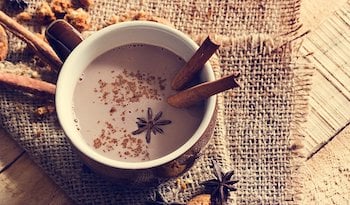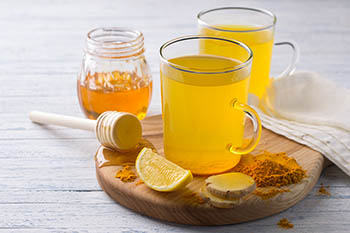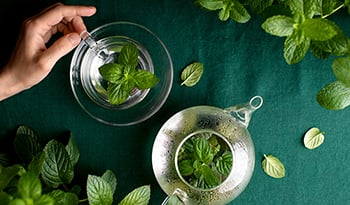From Green Tea to Ginger—8 Popular Teas + Their Health Benefits
DISCLAIMER:This blog does not intend to provide diagnosis...
- In this article:
- The Difference Between Black, Green, White, and Matcha Tea
- 1. Green Tea Benefits
- 2. Black Tea Benefits
- 3. Chamomile Tea Benefits
- 4. Ginger Tea Benefits
- 5. Kombucha Tea Benefits
- 6. Peppermint Tea Benefits
- 7. Rooibos Tea Benefits
- 8. Rosehip Tea Benefits

Originally Posted November 2018 / Updated January 2023
Drinking herbal teas provides many health benefits, but without question, the most popular tea is derived from Camellia sinensis, the green and black tea source. Black tea is the most popular of the two, as green tea represents only 20 percent of the nearly 2.5 million tons of dried tea produced yearly. Other popular teas consumed for enjoyment and health benefits include chamomile, ginger, peppermint, rooibos, and rosehip.
The Difference Between Black, Green, White, and Matcha Tea
The fundamental difference between the various teas from Camellia sinensis is how the leaves and buds are grown, harvested, and processed.
With black tea, the leaves are harvested and exposed to the environment. This results in the breakdown of the leaves through fermentation. In the process, compounds known as polyphenols oxidize, resulting in the browning of the tea leaves. Oxidation also leads to the production of many flavorful and aromatic compounds. The downside is that many of the active compounds in the leaves are converted to less beneficial compounds. In contrast, with green tea, the fresh-cut leaves are lightly steamed. The steam prevents the oxidation reaction, so the dried leaves are green. Oolong tea is partially oxidized, so it has black and green tea characteristics.
In the marketplace, there are more than 150 varieties of green tea, and there are many different quality grades of each green tea. White tea, for example, is a form of green tea made from unopened buds rather than leaves. White tea is milder in flavor, color (pale yellow) and lower in both polyphenols (the active compounds) and caffeine than green tea.
While white tea is a weaker form of green tea, matcha is a super-powered form.1 It can contain as much as 100 times higher levels of particular catechins than regular green tea. To produce matcha, the tea plants are shade-grown for three weeks before harvesting. The leaves are trimmed from the tree with the stems and veins removed, then ground into a fine powder. Matcha is very vibrant in its green color as well as in its taste. At the same time, it is lighter and sweeter than regular green tea. Matcha produced from the tips of the leaf is regarded as the highest quality and the form traditionally used in the cultural Japanese green tea ceremony.
1. Green Tea Benefits
Green tea provides more significant health benefits than black tea (or white tea).2,3 Although green tea contains vitamins and minerals, it is also a rich source of polyphenols that are key to its health benefits and why it stands above black and white tea.
The most important polyphenols in green tea are catechins and other flavonoids. Dried green tea leaf has a polyphenol content of 8% to 12%. It also provides caffeine (3.5%) and theanine (4%), a unique amino acid that dampens some of the effects of caffeine while also promoting the feeling of calmness, mental clarity, and focus.
Green tea consumption has shown protective effects against heart disease and chronic disease and positive effects on immune health and obesity.3-5 However, achieving the full benefit is dose-related. Specifically, the intake of green tea polyphenols must be sufficient. Achieving the full benefits of green tea requires an intake of 4 to 6 cups of green tea or 1 to 2 cups of matcha daily. These levels translate to taking a dosage of green tea extract that provides 400 to 600 mg of total polyphenols daily. Remember that green tea contains caffeine, about 30 mg per 8 oz cup of green tea, and a little more than twice that amount in a cup of matcha. For comparison, a cup of coffee generally has more than three times this amount at about 100 mg per cup.
2. Black Tea Benefits
Black tea contains about 50 milligrams of caffeine per cup, making it one of the most highly caffeinated types, but about half the caffeine as a cup of coffee. In addition to caffeine, it contains a rich source of tannins. These compounds are the polyphenols of green tea that have complexed together to form much larger molecules. They are called tannins because they were used in producing leather. The tannins, catechins, and related compounds in black tea exert their health benefits. For example, tannin compounds known as theaflavins and thearubigins are effective antioxidants that black tea extracts rich in these compounds have been shown to promote vascular health and reduce cholesterol levels.5
3. Chamomile Tea Benefits
Chamomile is an herbal tea made from the flowers of the chamomile plant (Matricaria chamomilla). It has been used medicinally for centuries primarily for gastrointestinal complaints and to help promote a good night’s sleep.6 Research also points to the benefit of chamomile tea in improving antioxidant status and blood sugar control.7 Studies with oral chamomile preparations have also shown benefits in boosting mood scores, promoting feelings of calmness, and reducing joint discomfort.6
4. Ginger Tea Benefits
Ginger (Zingiber officinalis) is a powerhouse of health benefits, whether it is used as a culinary ingredient, taken as a tea, or as a dietary supplement. It is one of the most well-researched medicinal plants, with over 5,000 scientific investigations. One of its more popular uses is helping with minor digestive complaints such as intestinal gas and cramping.8 These benefits, like many other of ginger’s health effects, are attributed to its rich source of aromatic compounds. Here is a brief list of the key uses of ginger.
- Colds and flu. Ginger is a great aid to help bolster immune function and ease some of the discomforts of viral infections. It is a diaphoretic, which encourages perspiration and can aid both chills and fever. Ginger tea is a great choice anytime you want to warm up and feel good!
- Nausea, vomiting, and motion sickness. Clinical studies show ginger can help with gastrointestinal and other symptoms associated with motion sickness, pregnancy, chemotherapy, and other causes. Ginger slows the communication between the gastrointestinal tract and the nausea center in the brain. It does by absorbing and neutralizing toxins, hormones, and bile acids.8,9
- Inflammation and joint health. Ginger exerts significant anti-inflammatory actions that can help ease joint discomfort.9,10
- Headaches. Ginger possesses numerous effects that can help the ease of a headache.9,10
- Menstrual cramps. Ginger can help ease menstrual discomfort.9
- Metabolic syndrome. A considerable amount of research shows ginger can help support metabolism, blood sugar control, weight loss, and cholesterol levels.11,12 These effects are due to a myriad of mechanisms. For example, ginger’s weight loss effects are through increasing thermogenesis, increasing the breakdown of fat cells (lipolysis), suppression of the formation of new fat cells (lipogenesis), inhibiting intestinal fat absorption, and controlling appetite.12
5. Kombucha Tea Benefits
Kombucha is a tea made from the Manchurian mushroom.
Traditionally kombucha tea is prepared by taking a flat mushroom and fermenting it in black or green tea along with some sugar or other carbohydrate for around seven days. The fermentation process creates a probiotic and antioxidant-rich drink with many health benefits, significantly improving digestion and inflammation. Remember that since kombucha also contains green or black tea, it also provides the benefits of those teas.
6. Peppermint Tea Benefits
Peppermint is an herbal tea made from the leaves of the peppermint plant. In addition to being consumed as a relaxing beverage, peppermint tea has been used as a folk remedy for many purposes including for digestive health, support during the common colds, headaches, menstrual pain, and many more. Modern research has supported some of these uses, especially peppermint, in promoting digestive health.13 But the best use of peppermint tea is for its enjoyment and stress-relieving effects.
7. Rooibos Tea Benefits
Rooibos is an herbal tea made from the leaves of the rooibos plant (Aspalathus linearis), a bush found in Africa. It is known for its red color, good taste, and many health benefits. Rooibos is caffeine-free, so having a cup before bed is a healthful habit. Like other plants, rooibos contains antioxidants that may help prevent heart disease, chronic disease, and other age-related disorders.14 Two antioxidants in rooibos, nothofagin and aspalathin, also help boost immune function. And rooibos tea has shown a number of anti-aging effects.
8. Rosehip Tea Benefits
Rosehip is an herbal tea made from dried or crushed rose hips or the rose plant’s fruit (Rosa canina). Rosehips are a good source of Vitamin C as well as many flavonoids and other polyphenols. The combination of vitamin C and flavonoids in rosehip can strengthen the vascular and immune system as well as support joint health.15
References:
- Sokary S, Al-Asmakh M, Zakaria Z, Bawadi H. The therapeutic potential of matcha tea: A critical review on human and animal studies. Curr Res Food Sci. 2022 Nov 23;6:100396.
- Tenore GC, Daglia M, Ciampaglia R, Novellino E. Exploring the nutraceutical potential of polyphenols from black, green and white tea infusions – an overview. Curr Pharm Biotechnol. 2015;16(3):265-71
- Zhao T, Li C, Wang S, Song X. Green Tea (Camellia sinensis): A Review of Its Phytochemistry, Pharmacology, and Toxicology. Molecules. 2022 Jun 18;27(12):3909.
- Chen J, Zhang Z, Yu P, Gan W, Ren K, Zhang F, Chen F, Wang M, Bao J, Wang T. Beneficial effects of green tea on age related diseases. Front Biosci (Schol Ed). 2020 Jan 1;12(1):70-91.
- Brimson JM, Prasanth MI, Kumaree KK, et al. Tea Plant (Camellia sinensis): A Current Update on Use in Diabetes, Obesity, and Cardiovascular Disease. Nutrients. 2022 Dec 21;15(1):37.
- El Mihyaoui A, Esteves da Silva JCG, Charfi S, et al. Chamomile (Matricaria chamomilla L.): A Review of Ethnomedicinal Use, Phytochemistry and Pharmacological Uses. Life (Basel). 2022 Mar 25;12(4):479.
- Zemestani M, Rafraf M, Asghari-Jafarabadi M. Chamomile tea improves glycemic indices and antioxidants status in patients with type 2 diabetes mellitus. Nutrition. 2016 Jan;32(1):66-72.
- Nikkhah Bodagh M, Maleki I, Hekmatdoost A. Ginger in gastrointestinal disorders: A systematic review of clinical trials. Food Sci Nutr. 2018 Nov 5;7(1):96-108.
- Unuofin JO, Masuku NP, Paimo OK, Lebelo SL. Ginger from Farmyard to Town: Nutritional and Pharmacological Applications. Front Pharmacol. 2021 Nov 26;12:779352. Kim S, Cheon C, Kim B, Kim W. The Effect of Ginger and Its Sub-Components on Pain. Plants (Basel). 2022 Sep 2;11(17):2296.
- Ballester P, Cerdá B, Arcusa R, et al. Effect of Ginger on Inflammatory Diseases. Molecules. 2022 Oct 25;27(21):7223.
- Wang J, Ke W, Bao R, Hu X, Chen F. Beneficial effects of ginger Zingiber officinale Roscoe on obesity and metabolic syndrome: a review. Ann N Y Acad Sci. 2017 Jun;1398(1):83-98.
- Ebrahimzadeh Attari V, Malek Mahdavi A, et al. A systematic review of the anti-obesity and weight lowering effect of ginger (Zingiber officinale Roscoe) and its mechanisms of action. Phytother Res. 2018 Apr;32(4):577-585.
- Mahendran G, Rahman LU. Ethnomedicinal, phytochemical and pharmacological updates on Peppermint (Mentha × piperita L.)-A review. Phytother Res. 2020 Sep;34(9):2088-2139.
- Nogueira Silva Lima MT, Boulanger E, Tessier FJ, Takahashi JA. Hibiscus, Rooibos, and Yerba Mate for Healthy Aging: A Review on the Attenuation of In Vitro and In Vivo Markers Related to Oxidative Stress, Glycoxidation, and Neurodegeneration. Foods. 2022 Jun 7;11(12):1676.
- Ayati Z, Amiri MS, Ramezani M, et al. Phytochemistry, Traditional Uses and Pharmacological Profile of Rose Hip: A Review. Curr Pharm Des. 2018;24(35):4101-4124.

 By Dr. Michael Murray, N.D.
By Dr. Michael Murray, N.D. 


